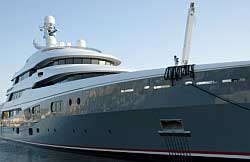It is common on a luxury chartered Yacht to acquire a set of skills that greatly exceed your job ‘title.’ Here however, are a few of the positions that you might see onboard a yacht. Salaries for an employee on a yacht vary extremely and are not listed below. Employees should research their earning potential and specific job expectations before committing to a job onboard a yacht.
Yacht Captain

The captain is the first in charge onboard and is responsible for all of his crew and passengers. He must understand all aspects of the boat and takes on an administrative role as well as all navigational duties. Each captain has different standards for his/her boat and usually interacts with passengers, having a more intimate relationship with the crew than on a larger ship. Captains must be licensed, have significant maritime experience and have spent time as a first mate or in an equivalent role onboard other ships.
Yacht Engineer
Luxure yacht engineers make sure the mechanics of the vessel are functioning properly. This includes trouble shooting and fixing any number of functional problems. Plumbing included.
Deckhands and Ship Mates
Employees in these positions are responsible for the exterior maintenance of the ship and often have a variety of duties. They assist guests and usually gain intimate relationships with them. They accompany guests during excursions and almost certainly have the widest variety of responsibilities.
Chef
The type of chef is directly related to the type of yacht. Luxury Yachts demand luxury chefs. Almost all yacht chefs however, work with a smaller staff and have a great deal of creative freedom. Ordering, food quality standards, cleaning, preparing and serving may all fall under the responsibility of a yacht chef.
Steward/Stewardess
A person in this position is highly visible to passengers. He/She acts as sort of hands on customer service representative and might serve drinks, answer questions, help with luggage, serve meals and aid guests in anyway that he/she can. A very outgoing and friendly personality is required.
Yacht Pilots
Pilots are common on luxury cruises and are often hired by owners to direct the boat. On smaller ships this position is included in the captain’s duties.
First Mate
First Mates act as the second hand to the captain. They assist in the captain’s duties and take on the responsibilities of the ship should something happen to the captain. First Mates train and assist crewmembers. They delegate ship responsibility and keep a close eye on safety regulations and protocols. They must be properly licensed and experienced.
Yacht Safety Officer
Safety Officers maintain the safety equipment onboard. They run protocols and drills, taking pains to ensure guests and staff abide to the safety rules and regulations of the ship.
Yacht Purser
The Purser acts as an accountant onboard. Some luxury yachts require maintenance and staff totaling up to a million dollars or more a year. They budget trips and maintain accounts relating the ship.
Laundry Steward
A Laundry Steward on a luxury yacht collects, cleans and delivers laundry for the guests and other staff members onboard. On smaller yachts, this responsibility is shared among the deckhands.
Yacht Delivery Work
Delivery Work entails moving the yacht from location to location based on the owner or captain’s needs. This work is contract work and not for a full time employee.
Licensing and Work Requirements
While some positions onboard require a specific number of previous ship-hours and a specialized set of skills, others are great for the boating novice. It all depends on the needs of the yacht and the person applying. Many yacht captains are willing to train, in hopes of finding deckhands that they can mold into the perfect onboard employee. The IMO, or International Maritime Organization has worked hard to standardize safety precautions for ships. The Standard of Training Certificates and Watch Keeping (STCW) was developed by the IMO and is a required training program and certification of nearly every crew member onboard a ship. Some positions allow you to apply with out already having this certification and others require that you already be certified. The training takes about a week and because of its popularity as an onboard requirement, there are facilities all over the world.

